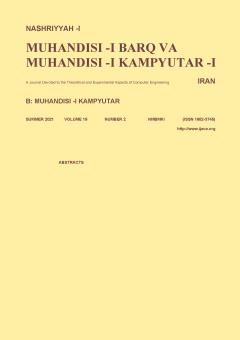Improved Semi-Quantum Direct Communication Protocol
Subject Areas : electrical and computer engineering
1 -
2 - دانشگاه بین المللی امام رضا(ع) مشهد
Keywords: Quantum cryptography, semi-quantum cryptography, semi-quantum secure communication, controller,
Abstract :
Unlike classical cryptography, where security is based on computational complexity, quantum cryptography has unconditional security, which is based on physical constraints. So far, the semi-quantum version of many of the problems of secure quantum communication protocols has been proposed. In this study, we examined semi-quantum protocols that allow users to access a secret message directly without distributing the key. An important factor used to analyze the performance of secure quantum direct communication protocols is efficiency. In this study, the proposed semi-quantum secure communication protocol against various quantum attacks has been investigated. In the proposed scheme for decoding the confidential message by the receiver, a sequence of single photons is required, which is first generated by the controller. The proposed protocol has a yield of 50%, which is higher than the previous protocol, which has a yield of 66.6%.
[1] M. Boyer, D. Kenigsberg, and T. Mor, "Quantum key distribution with classical Bob," in Proc. IEEE 1st Int. Conf. on Quantum, Nano, and Micro Technologies, ICQNM'07, pp. 10-10, Guadeloupe, French, 2-6 Jan. 2007.
[2] م. هوشمند و ش. حسنپور، "ارتباط مستقیم امن کوانتومی کنترلشده با هدف افزایش بازدهی،" مجموعه مقالات يازدهمين کنفرانس بینالمللی انجمن رمز ایران، 6 صص.، تهران، ايران، 12-11 شهريور 1393.
[3] G. E. Moore, "Cramming more components onto integrated circuits," Proceedings of the IEEE, vol. 86, no. 1, pp. 82-85, Jan. 1998.
[4] M. A. Nielsen and I. L. Chuang, Quantum Computation and Quantum Information, Cambridge University Press, 2001.
[5] T. P. Spiller, W. J. Munro, S. D. Barrett, and P. Kok, "An introduction to quantum information processing: applications and realizations," Contemporary Physics, vol. 46, no. 6, pp. 407-436, 2005.
[6] D. C. Marinescu and G. M. Marinescu, Approaching Quantum Computing, pp. 1-41, Pearson/Prentice Hall, 2005.
[7] M. Nakahara and T. Ohmi, Quantum Computing: From Linear Algebra to Physical Realizations, CRC Press, 2008.
[8] R. P. Feynman, "Simulating physics with computers," International J. of Theoretical Physics, vol. 21, no. 6/7, pp. 467-488, 1982.
[9] L. K. Grover, "A fast quantum mechanical algorithm for database search," in Proc. of the 28th Annual ACM Symp. on Theory of Computing, STOC’96, pp. 212-219, Philadelphia, PA, USA, 22-24 May 1996.
[10] P. W. Shor, "Algorithms for quantum computation: discrete logarithms and factoring," in Proc. IEEE 35th Annual Symp. on Foundations of Computer Science, pp. 124-134, Santa Fe, NM, USA, 20-22 Nov. 1994.
[11] S. Wiesner, "Conjugate coding," ACM Sigact News, vol. 15, no. 1, pp. 78-88, Jan. 1983.
[12] C. H. Bennett, G. Brassard, S. Breidbart, and S. Wiesner, "Quantum cryptography, or unforgeable subway tokens," Advances in Cryptology: Proceedings of CRYPTO '82, pp. 267-275, Santa Barbara, CA, USA, 23-25 Aug 1982.
[13] C. H. Bennett and G. Brassard, "Quantum cryptography: public key distribution and coin tossing," Theor. Comput. Sci., vol. 560, pp. 7-11, 2014.
[14] م. هوشمند، م. خرمپناه و ر. ساروقی، "ارسال محرمانه اطلاعات به کمک کیوبیتهای درهمتنیده،" مجموعه مقالات نهمين کنفرانس بینالمللی رمز ایران، 5 صص. تبريز، ايران، 24-23 شهريور 1391.
[15] X. Zou and D. Qiu, "Three-step semiquantum secure direct communication protocol," Science China Physics, Mechanics & Astronomy, vol. 57, no. 9, pp. 1696-1702, 2014.
[16] K. Thapliyal and A. Pathak, "Applications of quantum cryptographic switch: various tasks related to controlled quantum communication can be performed using bell states and permutation of particles," Quantum Information Processing, vol. 14, no. 7, pp. 2599-2616, 2015.
[17] Y. P. Luo and T. Hwang, "Authenticated semi-quantum direct communication protocols using bell states," Quantum Information Processing, vol. 15, no. 2, pp. 947-958, 2016.
[18] C. Shukla, K. Thapliyal, and A. Pathak, "Semi-quantum communication: protocols for key agreement, controlled secure direct communication and dialogue," Quantum Information Processing, vol. 16, no. 12, Article No.: 295, 2017.
[19] H. Lu, M. Barbeau, and A. Nayak, "Economic no-key semi-quantum direct communication protocol," in Proc. IEEE Globecom Workshops, GC Wkshps’2017, 7 pp., Singapore, Singapore, 4-8 Dec. 2017.
[20] J. Gu, P. H. Lin, and T. Hwang, "Double C-NOT attack and counterattack on ‘three-step semi-quantum secure direct communication protocol’," Quantum Information Processing, vol. 17, no. 7, Article No.: 182, 8 pp., Jul. 2018.
[21] C. Xie, L. Li, H. Situ, and J. He, "Semi-quantum secure direct communication scheme based on bell states," International J. of Theoretical Physics, vol. 57, no. 6, pp. 1881-1887, 2018.
[22] W. Zhang, D. Qiu, and P. Mateus, "Security of a single-state semi-quantum key distribution protocol," Quantum Information Processing, vol. 17, no. 4, Article No.: 2050013, 21 pp., 2018.
[23] L. C. Xu, H. Y. Chen, N. R. Zhou, and L. H. Gong, "Multi-party semi-quantum secure direct communication protocol with cluster states," International J. of Theoretical Physics, vol. 49, no. 1, Article No.: 1950004, 10 Jan. 2020.
[24] F. G. Deng and G. L. Long, "Controlled order rearrangement encryption for quantum key distribution," Physical Review A, vol. 68, no. 4, Article No.: 042315, Oct. 2003.


